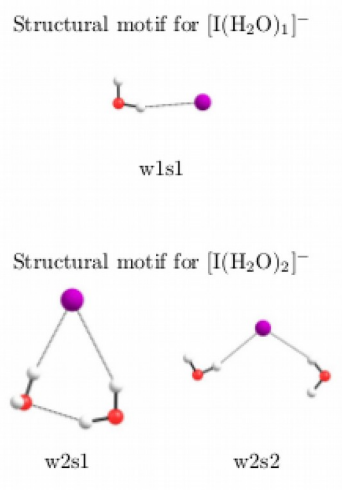Microsolvation and solvent effects on NMR magnetic shieldings of solvated I- anion
Yuly Chamorro1 , Alejandro Maldonado2 , Agustín Aucar2 , Edison Flórez3 , Gustavo Aucar2 and Albeiro Restrepo1
1 Instituto de Química, Universidad de Antioquia, Medellín, Colombia; 2UNNE University and IMIT Institute CONICET-UNNE, Corrientes, Argentina; 3Massey University Auckland, New Zeland
 Solvent effects are important in most of the biomolecular phenomena as well as the vast majority of chemical processes taking place in solution. The environment may strongly modify the properties of the system as compared to the isolated situation. Solvent effects can be considered, at least, in three different ways: (i) by explicit inclusion of solvent molecules (microsolvation); (ii) by using a continuum solvation model (global solvation); (iii) by the combination of models (i) and (ii) (liquid phase). The advantage of the microsolvation model is its capacity to describe explicitly specific local interactions as hydrogen bonds, but it is sizelimited and long-range effects of a polar solvent are absent. In this research we explore the microsolvation of the I- anion with up to six water molecules. We analized energies, population of the different motifs as well as response properties like NMR magnetic shieldng, and relativistic effects on all of them as it was done in previous work[1]. The search of the geometries of different structural motifs of the ion interacting with solvent molecules was performed through the potential energy surface (PES) with the ASCEC method [2]. Random exploration were carried out using the B3LYP hybrid functional in conjunction with pseudopotentials to generate candidate structures. For the relativistic and correlation effects, two types of optimizations were carried out: scalar relativistic and four-component at MP2 level. Relativistic optimizations were carried out by using the DHF Hamiltonian. The NMR magnetic shielding calculations were carried out with relativistic polarization propagator approach (Rel-PPA) [3]. We found important solvent effects on intrinsic and response properties in the systems under study. The nuclear magnetic shielding of heavy-ion reduces their values up to 6% due to solvent effects.
Solvent effects are important in most of the biomolecular phenomena as well as the vast majority of chemical processes taking place in solution. The environment may strongly modify the properties of the system as compared to the isolated situation. Solvent effects can be considered, at least, in three different ways: (i) by explicit inclusion of solvent molecules (microsolvation); (ii) by using a continuum solvation model (global solvation); (iii) by the combination of models (i) and (ii) (liquid phase). The advantage of the microsolvation model is its capacity to describe explicitly specific local interactions as hydrogen bonds, but it is sizelimited and long-range effects of a polar solvent are absent. In this research we explore the microsolvation of the I- anion with up to six water molecules. We analized energies, population of the different motifs as well as response properties like NMR magnetic shieldng, and relativistic effects on all of them as it was done in previous work[1]. The search of the geometries of different structural motifs of the ion interacting with solvent molecules was performed through the potential energy surface (PES) with the ASCEC method [2]. Random exploration were carried out using the B3LYP hybrid functional in conjunction with pseudopotentials to generate candidate structures. For the relativistic and correlation effects, two types of optimizations were carried out: scalar relativistic and four-component at MP2 level. Relativistic optimizations were carried out by using the DHF Hamiltonian. The NMR magnetic shielding calculations were carried out with relativistic polarization propagator approach (Rel-PPA) [3]. We found important solvent effects on intrinsic and response properties in the systems under study. The nuclear magnetic shielding of heavy-ion reduces their values up to 6% due to solvent effects.
[1] E. Flórez, A. F. Maldonado, G. A. Aucar, J. David and A. Restrepo, Phys. Chem. Chem. Phys. 2016, 18, 1537.
[2] J. Pérez y A. Restrepo, ASCEC V-02: Annealing Simulado con Energı́a Cuántica., Property, Development and Implementation. GQFT, Universidad de Antioquia, Medellı́n (2008).
[3] G. A. Aucar, R. H. Romero and A. F. Maldonado, Int. Rev. Phys. Chem. 2010, 29, 1.